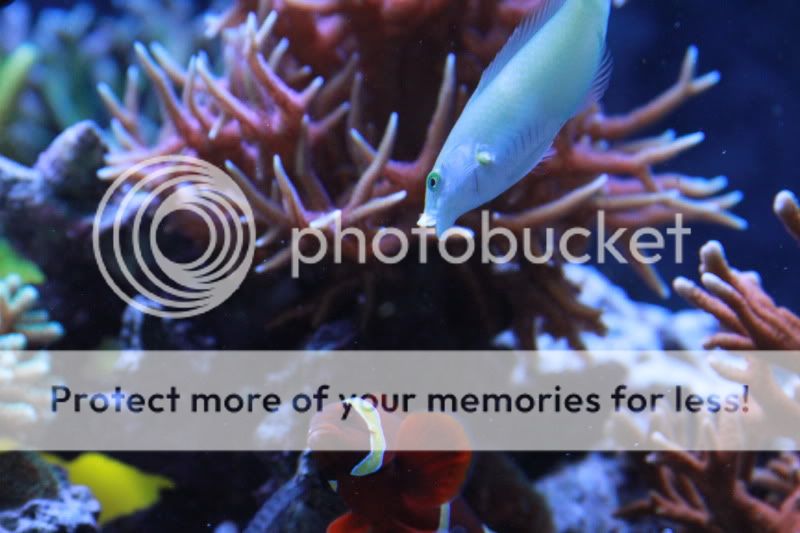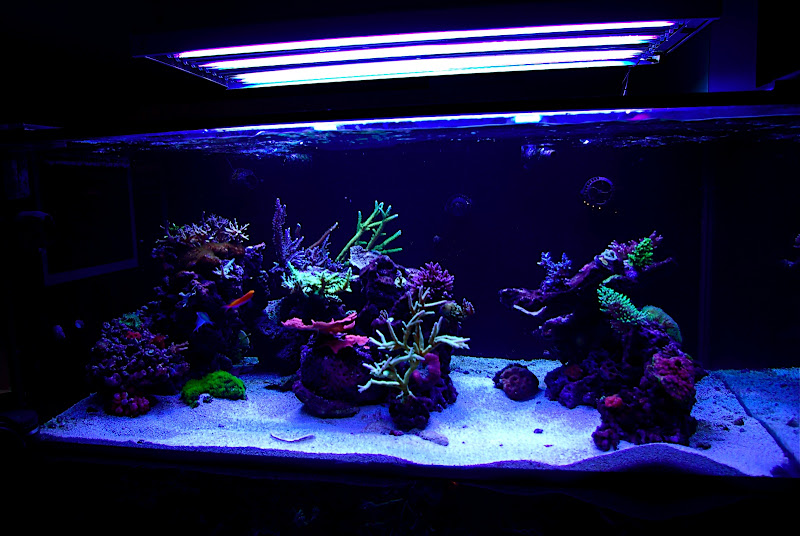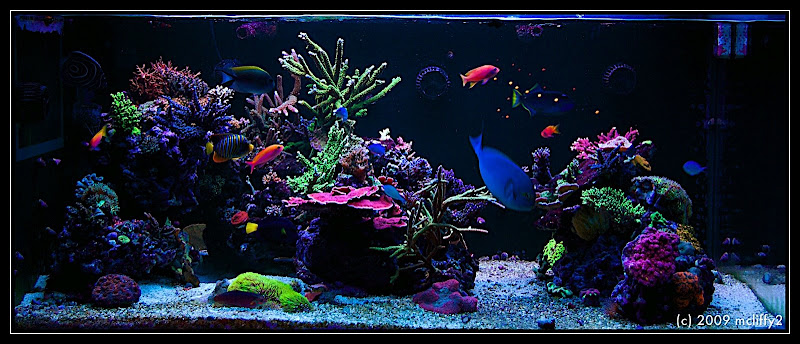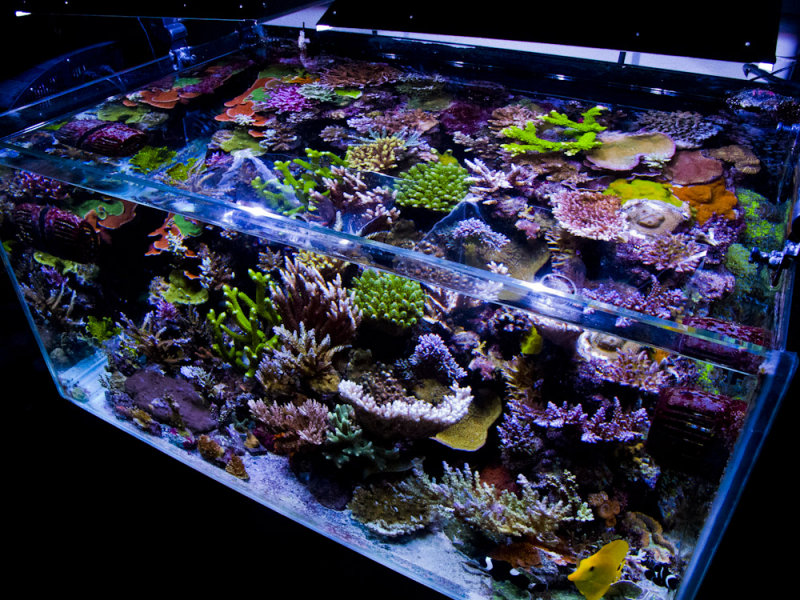Old thread, but great one. I discovered AEFWs in my tank this past weekend %#%^!.... A purple Millie that I have in my tank started to show distress.. It turned a light color, then the polyps retracted.. slowly over a few days it started to STN.. I was puzzled because, I have a frag that broke off this colony on the opposite end of the tank and it is doing fine.. So, I decided to take a turkey baster to the colony and white flatforms that I could not see before were blowing all over the place.. Two of my wrasses and two carberry anhias went into a feeding frenzy with my red wrasse (name unknown) being the leader of the pack.. I don't have any facitilty to remove all of my corals for QT and many of them are encrusted so, I will try the maxijet method for a while and see if I can get the population down.. I did baste all the other corals in the tank, but did not see any AEFWs fly off.. On sunday I went out and picked up a leopard wrasse, sixline and another carberry tp assis in the fight. Wish me luck with this battle.. I'm consideraing a few super dose treatments of FWE.., which I've seen some folks have good results with... any updates from those who have been dealing with these pests for a while?
You are using an out of date browser. It may not display this or other websites correctly.
You should upgrade or use an alternative browser.
You should upgrade or use an alternative browser.
Success with "living with" AEFW - potential predator or different variety of AEFW?
- Thread starter mcliffy2
- Start date
cwegescheide
YOU have been ignored!
Never heard of AEFW releasing toxins after death, I have definitely heard of red planaria releasing nasty toxins that can cause death to the tank if they die in huge numbers. I think it may be important to distinguish the difference between the 2. I do not know FWE to kill AEFW, I think we are mistaken on the identity of the flatworms here.
GL
After I read this thread I dipped my corals in QT AGAIN for the third time in a week :lol:
I also give my frags a very strong treatment in QT with FWE. Probably 2 to 3x the reccomended dose. As far as AEFW goes I have been using Coral RX concentrate and Revive.
4 more weeks and this round of QT'd corals are going in the tank. Some of the corals have already been in QT for a month but I couldn't resist getting a few more corals from my buddy Perry..
They are looking a little rough, I'm not going to lie but the first batch I QT'd came around looking pretty good after about 3 weeks. My feeling is I'd MUCH rather kill a couple corals in QT than potentially a bunch dieing later from an infestation. I know this thread is about living with them but...
Quick update guys... I decided not to treat the tank with anything and just live with them since I really have no facility to remove all the corals and quarantine.. I purchased a couple of green coris wrasse on a whim about 5 weeks ago. I have not seen a single flatworm in the last three weeks.. In addition all the affected corals have either regenerated or in the process of coming back strong.. It's pretty amazing. These guys stay hunting around the coral and rock. I could see them snatch worms right off the corals.. They can be a little nasty to each other and don't like being picked on by other fish, but I haven't witnessed any harm done to any fish.. I added them in a pair.. Here is a pic for reference of one staring down my GSM..


Spartanman22
New member
I just recently noticed AEFW on an unknown acro this past week and after reading up on the topic, I have decided to go about the basting method. The QTing method seems too stressful especially since most of my acros are fully encrusted onto the rock, and I don't have the space or funds to set up a qt tank (poor college student). I have basted the effected coral and have a few AEFW fell off and my yellow coris wrasse went nuts for them. I basted two other acros that had a few bite marks but nothing came off. So I am planning on using a maxi-jet instead of basting for now on. Basting along with my plans to add a leopard wrasse, melanurus wrasse, and a radiant wrasse should keep the population very low.
Moser
Active member
Very interesting thread... Its a shame it died...Any updates?.
Some of you may have been living with the flatworms for a few years with basting?.
I wonder if you basted frequently enough and managed to get to all the flatworms say over several basting cycles, whether you could have them eaten before they lay eggs?
Could that clear a tank??.
Very interested to hear about this method more...
Mo
Some of you may have been living with the flatworms for a few years with basting?.
I wonder if you basted frequently enough and managed to get to all the flatworms say over several basting cycles, whether you could have them eaten before they lay eggs?
Could that clear a tank??.
Very interested to hear about this method more...
Mo
Moser
Active member
Stunning as ever!.
Did you ever try a maxijet to blow them off?. Just wondering if you're likely to blow off more with an automated pump?
Do you manage to baste underneath the acros as well?. It seems that many tanks get raging infestation underneath acoral, well before signs on the top side, so reaching underneath corals may blow off a lot more....
What wrasses are you keeping at the moment?.
Thanks
Mo
Did you ever try a maxijet to blow them off?. Just wondering if you're likely to blow off more with an automated pump?
Do you manage to baste underneath the acros as well?. It seems that many tanks get raging infestation underneath acoral, well before signs on the top side, so reaching underneath corals may blow off a lot more....
What wrasses are you keeping at the moment?.
Thanks
Mo
jrizo1
New member
Put the crab in your acro you won't have Flatworm.
what type of crab
An initial disclaimer: please do not turn this into a debate over the merits of trading from an AEFW tank (I think we can all agree that disclosure is a must). I want to focus on what allows some to succeed and have a beautiful, thriving tank by just basting (or even just letting the AEFW go), and see if some trends can be identified, since IME, having AEFW has not been a big deal (see the before and after shots below).
The reports on "living with" AEFW (i.e. just basting them off periodically) seem to vary drastically. Some report that they have completely eradicated them by basting (ReefBum's gorgeous TOTM comes to mind), while others report that they are able to keep them in check enough that their system still thrives (I fall in this category), while others report that even with basting the problem got out of control and acros were being killed off.
Now having been someone who has "lived" with AEFW for almost a year, I think its safe to say, in at least some cases, you can be successful despite having AEFW in your system. Seeing the variations in success using basting, however, I think there may be more at play than just basting. I have two theories personally, as to why AEFW have not been a big deal in my tank:
1. Potential AEFW Predator -- I have a Christmas wrasse that I believe may keep AEFW in check, keeping their population to a low enough level that corals
grow faster than AEFW can eat them.
2. Different species of AEFW -- I have noticed that my AEFW don't go after my valida and nana, as others commonly report, and instead prefer millies and prostatas.
In effort to try and identify whether either of the above plays a role, it would be helpful to take a survey of those who have attempted the basting method.
If you have please post the following info:
(1) your experience with basting (successful or no?)
(2) your fish list (include all for sake of completeness)
(3) corals upon which you observed the most AEFW damage
I'll start:
(1) Experience (described above)
(2)
Christmas wrasse
Emperor angel
regal angel
swallowtail angel
mata tang
purple tang
bimac anthias
bicolor anthias
target mandarin
green chromis
bangaii cardinals
blue throat trigger
lawnmower blenny
percula clown pair
neon gobies
(3) mine love millies and prostatas, and also hit my A. Aculeus (flashlight acro) and A. Austera. They don't seem to hit up my valida or nana, and I am 99% they have never touched my staghorns.
As evidence that somewhat long term success is possible without any drastic
QT and iodine dips, here is the tank as of Sep 08 (AEFW discovered in Aug 08):

And here is the tank as of June 09:

I "had" aefw and no longer do as far as my knowledge. I basted and bought a malunarus wrasse, a painted wrasse solarensis, had a mystery wrasse, and a spotted mandarin. My "painted wrasse" solarensis seemed to enjoyed the blown off aefw the most.
ReefBum
Active member
Thanks Mo. Nope....I have never used a power head and I don't really get underneath corals since those are hard to reach spots. I have had two Leopard Wrasses, an African and one with black spots, for 4 years now.Stunning as ever!.
Did you ever try a maxijet to blow them off?. Just wondering if you're likely to blow off more with an automated pump?
Do you manage to baste underneath the acros as well?. It seems that many tanks get raging infestation underneath acoral, well before signs on the top side, so reaching underneath corals may blow off a lot more....
What wrasses are you keeping at the moment?.
Thanks
Mo
Piper27
I love bengals
Just like to add what my experience has been...
Maybe 10 months ago I found aefw in my tank, I kept the numbers down for a while with revive and basting until I got the nerve to do the weekly dip thing using revive. Did that for a number off weeks and had no signs of them since. They were only on validias and a few other similar corals, never on any millis. Maybe 2 months ago I did an interceptor treatment to get rid of the red bugs I noticed. A month later I found aefw on a milli and a tricolor. I had bought a few fresh cut frags in between but I am pretty sure I didn't introduce any new kinds of flatworms. I know this doesn't fall in the living with them catagory but I just thought it was odd that they would be living on different corals the second time I noticed them. They don't seem to be any more or less agressive this time around either (but I sure didn't give them a chance so who knows). I am now on week 3 of dips and plan on doing the dips for at least 8 weeks to hopefully get all of them.
Good thread too, I hope people keep sharing.
Maybe 10 months ago I found aefw in my tank, I kept the numbers down for a while with revive and basting until I got the nerve to do the weekly dip thing using revive. Did that for a number off weeks and had no signs of them since. They were only on validias and a few other similar corals, never on any millis. Maybe 2 months ago I did an interceptor treatment to get rid of the red bugs I noticed. A month later I found aefw on a milli and a tricolor. I had bought a few fresh cut frags in between but I am pretty sure I didn't introduce any new kinds of flatworms. I know this doesn't fall in the living with them catagory but I just thought it was odd that they would be living on different corals the second time I noticed them. They don't seem to be any more or less agressive this time around either (but I sure didn't give them a chance so who knows). I am now on week 3 of dips and plan on doing the dips for at least 8 weeks to hopefully get all of them.
Good thread too, I hope people keep sharing.
doca
New member
Update: I just snagged one at about 1/4", thing was huge... I put into a glass, added tap water to kill/ stun him, put at the tip of the baster, when I went up to the tank, my fish were there to feed. I released the AEFW back into the water, and guess which fish devoured it instantly? My CBB...
any one can tell me what is the CBB fish??
DrHarryLopez
One Happy Reefer
(1) your experience with basting (successful or no?)
I beleive in the natural predators theory as I gathered that I wasn't immune to AEFWs. However, when I set up an autofeeder to feed several times per day my fish (specifically the wrasse and hawkfish) stopped hunting for food. They were always healthy looking but after the feeder they became obese, then I believe eventually I had an overgrowth of AEFWs population and made its appearance.
A few weeks ago I removed the autofeeder, dip those coral that I could remove from the reef, fragged those that I couldn't, and began vigorous turkey basting corals. I feed only every other day.
I found a total of 8 AEFWs AND none in the last few weeks. I believe in my opinion, they must have been in my tank all this time and kept in check by natural predators.
(2) your fish list (include all for sake of completeness)
Main Display Tank (All one system)
Yellow Tang 2003 (8 yrs old)
Spotted Hawkfish 2006
Powder Blue Tang
Six-line Wrasse
Starry Blenny
Maroon Clown mated pair
Yellow Goby
Hippo Tang
Naso Tang Large
Bartlett Anthias School of 9
Lagoon tank
Ocellaris Clownfish
Ocellaris Clownfish
Yellow Tang
Clarkii Clownfish
Leopard Wrasse
Yellow Tang
Black Goby male
Black Goby female
Refugium
Lemon Peel Angel
V-Tail Grouper
Yellow Tang
(3) corals upon which you observed the most AEFW damage
A. nana, A. valida, A. tenuis
I beleive in the natural predators theory as I gathered that I wasn't immune to AEFWs. However, when I set up an autofeeder to feed several times per day my fish (specifically the wrasse and hawkfish) stopped hunting for food. They were always healthy looking but after the feeder they became obese, then I believe eventually I had an overgrowth of AEFWs population and made its appearance.
A few weeks ago I removed the autofeeder, dip those coral that I could remove from the reef, fragged those that I couldn't, and began vigorous turkey basting corals. I feed only every other day.
I found a total of 8 AEFWs AND none in the last few weeks. I believe in my opinion, they must have been in my tank all this time and kept in check by natural predators.
(2) your fish list (include all for sake of completeness)
Main Display Tank (All one system)
Yellow Tang 2003 (8 yrs old)
Spotted Hawkfish 2006
Powder Blue Tang
Six-line Wrasse
Starry Blenny
Maroon Clown mated pair
Yellow Goby
Hippo Tang
Naso Tang Large
Bartlett Anthias School of 9
Lagoon tank
Ocellaris Clownfish
Ocellaris Clownfish
Yellow Tang
Clarkii Clownfish
Leopard Wrasse
Yellow Tang
Black Goby male
Black Goby female
Refugium
Lemon Peel Angel
V-Tail Grouper
Yellow Tang
(3) corals upon which you observed the most AEFW damage
A. nana, A. valida, A. tenuis
DrHarryLopez
One Happy Reefer
Cardiff R33
New member
great thread. I have these at present and am trying to dip and will also try the new KZ product.
I am looking to get a CBB anyway so plan on getting one tonight as it may help gobble them up (and eat my aips!)
I am looking to get a CBB anyway so plan on getting one tonight as it may help gobble them up (and eat my aips!)
johnnie1960
New member
1 yellow damsel did the trick for me
Any of the original posters in this thread still having success with the basting method? I just found out I have AEFW....very depressing. However, it is encouraging to see great tanks "living with them", but was curious as to how long you were able to "live with them?"
Also - what is better? A turkey baster or maxi-jet? I am worried about corals loosing flesh from the constant blowing at close ranges, every few days!
Also - what is better? A turkey baster or maxi-jet? I am worried about corals loosing flesh from the constant blowing at close ranges, every few days!
JPMagyar
New member
Every time someone posts in this thread I am going to quote Keith (ReefBum).
Look at this tank and tell me you can't live with AEFW. Also the main display tank at Greenwich Aquaria HAD AEFW and it too is a "stunner" of a SPS tank, AND I had AEFW but have not seen evidence of them for years and my personal belief is that coral gobies kept in large enough quantities will eat any coral pest there is . . .
Again, look at Keith's tank and realize he had AEFW. You can control them without resorting to chemical warfare. Patience and diligence.
Look at this tank and tell me you can't live with AEFW. Also the main display tank at Greenwich Aquaria HAD AEFW and it too is a "stunner" of a SPS tank, AND I had AEFW but have not seen evidence of them for years and my personal belief is that coral gobies kept in large enough quantities will eat any coral pest there is . . .
Again, look at Keith's tank and realize he had AEFW. You can control them without resorting to chemical warfare. Patience and diligence.
Still basting weekly with a turkey baster and this method has certainly kept them in check. I have been doing this for years. Still see one fly off every now and then but the fish gobble them up. I'm sure my wrasses are also doing their part.

MammothReefer
Active member
I've been going on a couple years with AEFW. I use a maxi jet either once a week or every other week, and a baster whenever I'm just poking around the tank or something looks a little off and I need to check if it has it. Typically it's the same few corals that always get infected and reinfected. Sometimes if a piece isn't attached I will dip it now and then but not often.


Similar threads
- Replies
- 4
- Views
- 383
- Replies
- 0
- Views
- 94

